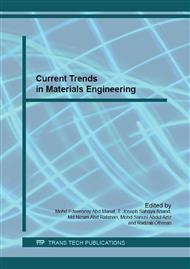[1]
L.W. De Jonge, C. Kjærgaard, P. Moldrup, Colloids and colloid-facilitated transport of contaminants in soils. Vadose Zone J. 3 (2004) 321-325.
DOI: 10.2113/3.2.321
Google Scholar
[2]
D. Ellison, Investigation of Pipe Cleaning Methods, American Water Works Association, Denver, (2003).
Google Scholar
[3]
N.S. Grigg, Water main breaks: Risk assessment and investment strategies, J. Pipeline Syst. Eng. Pract. 4 (2013) 4013001.
DOI: 10.1061/(asce)ps.1949-1204.0000142
Google Scholar
[4]
A. Amirat, A. Mohamed-Chateauneuf, K. Chaoui, Reliability assessment of underground pipelines under the combined effect of active corrosion and residual stress, Int. J. Press. Vessels Pip. 83 (2006) 107-117.
DOI: 10.1016/j.ijpvp.2005.11.004
Google Scholar
[5]
H.A. Kishawy, H. A. Gabbar, Review of pipeline integrity management practices. Int. J. Press. Vessels Pip. 87 (2010) 373-380.
DOI: 10.1016/j.ijpvp.2010.04.003
Google Scholar
[6]
H.S. Da Costa-Mattos, J.M.L. Reis, R.F. Sampaio, V.A. Perrut, An alternative methodology to repair localized corrosion damage in metallic pipelines with epoxy resins, Mater. Des. 30 (2009) 3581-3591.
DOI: 10.1016/j.matdes.2009.02.026
Google Scholar
[7]
H. Al-Barqawi, T. Zayed, Condition rating model for underground infrastructure sustainable water mains, J. Perform. Constr. Facil. (2006).
DOI: 10.1061/(asce)0887-3828(2006)20:2(126)
Google Scholar
[8]
R. W. Revie, Corrosion and corrosion control, 4th ed., John Wiley & Sons, Inc., New Jersey, (2008).
Google Scholar
[9]
R. Zuo, Biofilms: Strategies for metal corrosion inhibition employing microorganisms, Appl. Microbiol. Biotechnol. 76 (2007) 1245-1253.
DOI: 10.1007/s00253-007-1130-6
Google Scholar
[10]
L.L. Shreir, Corrosion: corrosion control (Vol. 2), Newnes, (2013).
Google Scholar
[11]
S.R.A. Saupi, M.A. Sulaiman, M.N. Masri, Effects of soil properties to corrosion of underground pipelines: A review, J. Trop. Resour. Sustain. Sci. 3 (2015) 14-18.
DOI: 10.47253/jtrss.v3i1.680
Google Scholar
[12]
S.R.A. Saupi, N.A.H. Abdul Haris, M.N. Masri, M.A. Sulaiman, M. B. Abu Bakar, M. H. M. Amini, Y.N.A.A.N. Mohamed Mazlan,. Effects of Soil Physical Properties to the Corrosion of Underground Pipelines. Mater. Sci. Forum, 840 (2016) 309-314.
DOI: 10.4028/www.scientific.net/msf.840.309
Google Scholar
[13]
N.A. Haris, A.S. Fatimah, M.A. Sulaiman, M.N. Masri, Effect of bacteria in soil towards the corrosion of water-pipeline: a review, J. Trop. Resour. Sustain. Sci, 3 (2015) 29-33.
DOI: 10.47253/jtrss.v3i1.682
Google Scholar
[14]
S. Li, S. Jung, K. Park, S.M. Lee, Y.G. Kim, Kinetic study on corrosion of steel in soil environments using electrical resistance sensor technique, Mater. Chem. Phys. 103 (2007) 9-13.
DOI: 10.1016/j.matchemphys.2007.02.076
Google Scholar
[15]
R.J. Kalinski, W.E. Kelly, Electrical-resistivity measurements for evaluating compacted-soil liners, J. Geotech. Eng. 120 (1994) 451-457.
DOI: 10.1061/(asce)0733-9410(1994)120:2(451)
Google Scholar
[16]
A.I.M. Ismail, A.M. El-Shamy, Engineering behaviour of soil materials on the corrosion of mild steel, Appl. Clay Sci. 42 (2009) 356-362.
DOI: 10.1016/j.clay.2008.03.003
Google Scholar
[17]
I.S. Cole, D. Marney, The science of pipe corrosion: A review of the literature on the corrosion of ferrous metals in soils, Corros. Sci. 56 (2012) 5-16.
DOI: 10.1016/j.corsci.2011.12.001
Google Scholar
[18]
H. Tamura, The role of rusts in corrosion and corrosion protection of iron and steel, Corros. Sci. 50 (2008) 1872-1883.
DOI: 10.1016/j.corsci.2008.03.008
Google Scholar
[19]
Information on http: /colleges. ksu. edu. sa/Engineering/final%20Report/KE_45_26_28. pdf.
Google Scholar
[20]
G.I. Ogundele, W.E. White, Some observations on corrosion of carbon steel in aqueous environments containing carbon dioxide, Corrosion 42 1986 71-78.
DOI: 10.5006/1.3584888
Google Scholar


